HRMM055 Assignment Sample
Here’s the best sample of HRMM055 Assignment, written by the expert.
1. Introduction
The main aim of the study is to analyse the attitudes and job satisfaction of employees and its impact on the motivation of the employees, it will analyse the impact on organizational behaviour as well. Additionally, it will depict the analysis of the motivational theory, which will help the employees in improving the performance of the organization. Furthermore, it will highlight the impact of attitude and job satisfaction on the motivation of the employees of the organization. The attitude of the organization has an important part in improving the performance of the organization.
2. Attitude
The cognitive consistency theory suggests that every employee has their personal views, preferences and they do not contradict with each other (Ekhsan et al. 2019). In this case, organizations are focused in improving the satisfaction of the employees. It will act as motivation factors for the employees of the organization. Besides this, it situation will improve the organizational culture. As mentioned by Waddimba et al. (2017), the consistency theory plays an important role in improving the performance of the organization. As this provide consistency of the behaviour of the employees. This signifies that this theory is more concerned about the inconsistencies that arise due to the beliefs and knowledge. Thus, by improving organizational culture the inconsistencies can be reduced, which in turn will change the psychological needs of the employees.
Therefore, it will improve the performance of the employees as the motivation of the employee and the attitude towards the work changes. As mentioned by Ekhsan et al. (2019), the belief of the organization changes with the performance of the employees, in case the performance of the employees, improves then that will improve the attitude of the employees.
The balance theory is more concerned with the consistency of judgement on the issues that are linked in a relationship in improving the organizational behaviour. As mentioned by Eliophotou-Menon and Ioannou (2016), there are mainly three elements that allow them in attitude formation. This includes all kinds of sentiment and relations that employees aim to balance all the three relations in an affirmative way. This situation is known as the employees are able to keep the relationship in a good way with the organization that improves the motivation of the employees at work place. Besides that, if there is a negative relation then it will be considered as an imbalance in the relationship.
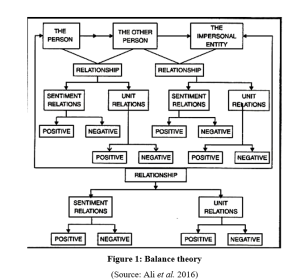
Additionally, in order to improve the motivation of the employees, the organization will have to maintain these relationships in an affirmative way that allows them to improving the organizational behaviour in front of the organization. As per the balance theory this in turn helps the organization in improving the motivation of employees. As cited by Liu and Perry (2016), if the employees of the corporation have a positive relationship with the management then automatically it will improve the motivation of the employees. Apart from that, it will improve the organizational culture of the organization. According to Ali et al. (2016), the organization focuses on creating a sentimental relationship with the employees which allows them in creating a good affirmative unit relation which in turn improves the efficiency of the organization.
The representatives of the association are engaged in improving fulfilment of the workers. This will be considered as inspiration factors for the representatives of the association other than that this circumstance will improve the hierarchical culture. The balance theory assumes a significant part in improving the exhibition of the association. As mentioned by Liu and Perry (2016), this means that this hypothesis is more worried about the irregularities emerging because of the convictions and information that allows them to improve the motivation of the employee at the work place. Hence, by improving hierarchical culture the irregularities can be decreased, which thus will change the mental needs of the representatives. Along these lines, it will improve the exhibition of the representatives as the inspiration of the worker and the disposition towards the work changes.
3. Job Satisfaction
The personality trait of employees within an organization is described by their job satisfaction. According to Rybnicek et al. (2019), job satisfaction significantly influences the behaviour and attitude of employees at the workplace. There are multiple factors such as pay scale, growth opportunities, workplace environment and many others which are needed to influence the satisfaction level among the employees. As cited by Cucina et al. (2018), job satisfaction of employees is determined by whether they like their job or not.
It is considered as an essential element of organizational objectives as the performance of employees is dependent upon their job satisfaction. The relationship with job satisfaction with a personal attitude of employees can be understood in the context factors such as employee wellbeing, work stress, work-life balance and other personal benefits (Coyne et al. 2017). The main focus of the HR managers of the present business world is on improving the job satisfaction level of employees because happy and satisfied employees are generally more productive than non-satisfied employees.
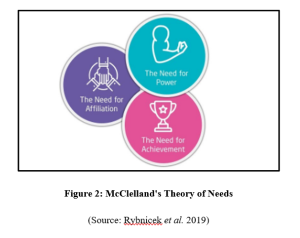
There are multiple theories that shed light on different patterns of job satisfaction within an organization. McClelland’s Theory of Needs has illustrated that every employee must have one of three key driving factors to enhance their job satisfaction namely, Achievement, Affiliation and Power. These motivators of job satisfaction are not inherent but are required to be developed through experiences and culture of life. As stated by Osemeke and Adegboyega (2017), people having achievement motivators prefer to work hard, and committed to achieving their goals.
A strong determination towards goals motivates them to perform better and increase their level of satisfaction. On the other hand, employees who have an affiliation motivator do not take a risk for gaining motivation or job satisfaction (Osemeke and Adegboyega, 2017). They are more concerned about workplace values and relationships than anything else. Moreover, those who have power as a motivator are more focused on personal development or power acquisition to gain job satisfaction. It can be understood from the analysis that high job satisfaction can be achieved based on the personal requirements of employees (Rybniceket al. 2019).
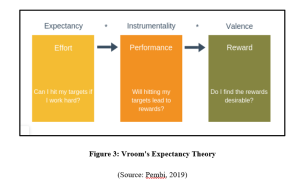
The concept of job satisfaction of employees within the workplace can further be understood with the help of Vroom’s Expectancy Theory. It is assumed in the expectancy theory that enhancement of job satisfaction is dependent upon the choices of possible alternative options, which have not been suggested in McClelland’s theory. According to Pembi (2019), choice of employees determines whether they are going to be benefitted or face challenges in the workplace. There are three essential components associated with Expectancy, Instrumentality and Valence.
Expectancy is dependent on the Effort, which enhances the performance of employees. Instrumentality is dependent on Performance, which is focused on the Outcome of the task. Valence is dependent on Outcome, which is facilitated by Reward. Based on this structured process of organization, the performance and job satisfaction of employees is determined. As mentioned by Yang and Kwon (2017), all the elements mentioned in the theory are essential for motivating and encouraging employees. Analysis of the theory illustrates that the level of satisfaction of employees is dependent upon how they pursue their goals, which is essential for meeting their specific needs.
Apart from the personal choices and efforts of employees, employers are responsible for enhancing the satisfaction level of employees. As discussed by Cucina et al. (2018), job satisfaction of employees can be enhanced to a significant level by understanding their expectations from an organization and meeting their expectations. Therefore, it can be concluded that the collaborative effort of employees and employers is essential for improving job satisfaction within the organization
4. Motivation
Performance and behaviour of employees within workplace premises is highly dependent upon motivation. As per Ziar et al. (2016), motivation is considered as a key driving factor that encourages and excites employees to contribute more to the growth and development of an organization. As cited by Alshmemri et al. (2017), the level of commitment and determination towards the organizational tasks and objectives are determined within the help of employee motivations. Therefore, the performance of employees significantly improves, which results in improving organizational performance. There are multiple theories that are developed based on improving employee’s motivation, however, Hertzberg’s Two Factor Theory is more specific as compared to others.
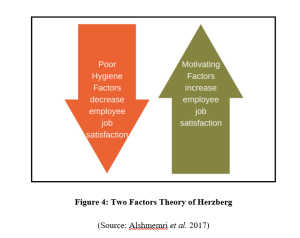
It has been argued in the Two Factors Theory of Herzberg that organizations can influence the motivation of employees focusing on two factors such as Motivating and Hygiene Factors. In order to increase the performance of employees (DV), organizations are required to improve motivation (IV) using these factors. Motivating factors in the workplace are essential for causing employees to work harder. As per Ziar et al. (2016), the motivating factors are usually found within the job itself. Some of the major examples of motivating factors in an organization are achievement, recognition, work process, advancement, responsibility and growth.
The above-mentioned motivators of organization increase the satisfaction level of employees, which eventually motivates them to perform better. Besides this, hygiene factors do not encourage employees or increase their satisfaction level. However, the absence of these factors can decrease the overall motivation of employees. As opined by Fareed and Jan (2016), hygiene factors are not present within the job, but on the aspects that are associated with the job. The most essential hygiene factors that are present in the workplace are company policies, healthy workplace environment, and supervision of managers, high salary and job security.
However, the theory does not pay attention to the personal situation or perception of employees. As argued by Ziar et al. (2016), this theory is mainly focused on the motivation of employees rather than increasing their productivity. However, it can be said at the end that the motivation level of employees is dependent upon their satisfaction level. Therefore, the employees of an organization can be motivated by satisfying them through limitations of hygiene issues and inclusion of motivators. The overall performance of the workplace is entirely dependent upon the motivation of employees towards performing their duties.
Unlike the Herzberg’s theory, the Adam’s Equity Theory pays attention to the personal choices of the employees to gain motivation within workplace. As cited by Ryan (2016), Equity Theory illustrates that employee are more likely to be motivated when they are treated well within a workplace. However, unfair and bias treatment within workplace can demotivate others who are not treated well.
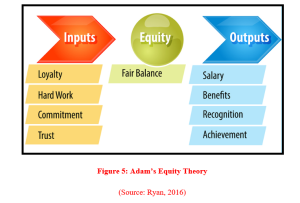
It has been found from the theory that managers are required to maintain equity between the inputs of employees that they bring to their job, and outputs that they receive from the organization. Inputs refer to the time and effort that is put on by the employees to increase the productivity of an organization (Ryan, 2016). On the other hand, outputs are the salary and other benefits that received by the employees in exchange of their hard work. It is believed by John Stacey Adam that employee value fair treatment within workplace is more than anything else. In order to increase the employee motivation, managers are required to ensure fair treatment within the workplace (Ryan, 2016).
5. Impact of attitude and job satisfaction on the motivation of the employees at work and organizational behaviour
The attitude of senior employees of an organization is important, as it allows the management in maintaining proper relationships with the employees. Based on the Balance theory of the attitudes, it is observed that the company can show a positive attitude towards the employees this will encourage them in enhancing the motivation of the employees (Octaviannand et al. 2017). Hence, in improving the inspiration of the employees, the association should keep up these connections in a good way that permits them in improving the hierarchical behaviour before the association.
Thus, it helps the association in improving the inspiration of representatives. As mentioned by Thokozani (2017) the representatives of the enterprise have a positive connection with the administration, at that point consequently it will improve the inspiration of the workers. This situation in the organization allows them to improve the attitude towards the employees which in turn improves the performance of the organization. It is considered as an essential element of organizational objectives as the performance of employees is dependent upon their job satisfaction.
The relationship with job satisfaction with a personal attitude of employees can be understood in the context factors such as employee wellbeing, work stress, work-life balance and other personal benefits (Coyne et al. 2017). The main focus of the HR managers of the present business world is on improving the job satisfaction level of employees because happy and satisfied employees are generally more productive than non-satisfied employees. Similarly, the job satisfaction of employees allows them to augment the motivation of employees. As per the Vroom’s expectancy theory, it can be suggested that if the employees are rewarded for their performance within the organization then it will enable them to improving the satisfaction of the employees. As mentioned by Thokozani (2017), the effort of the employees allows them to get success, which in turn improves the performance of the organization. They are aiming to improve the performance which will allow them to achieve the reward.
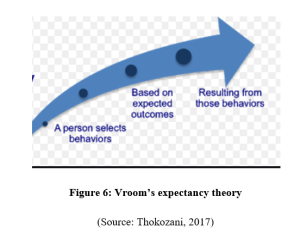
Besides that in McClelland’s theory of needs, there are three main factors: Achievement, affiliation and power. According to Thokozani (2017), in the affiliation phase if the employees are socially accepted then it will help the employees to establish a good relationship with others. Apart from that, it allows employees to get in the controls, which allows them to gain the achievement. This situation allows the employees to improve their relationship with others.
In Hertzberg’s two factor theory, the hygiene factors and fulfilment of basic needs allows them to gain motivation. Thus establishing a good relationship with the employees allows them to gain responsibility within the organization. As mentioned by Thokozani (2017), this perspective encourages them in achieving a higher position in the organization. This creates a positive impact on the motivation of employees. Besides that this situation in the company improves the performance of the employees.
The factors of hygiene are required to guarantee that a researcher is not disillusioned. Motivation factors are required for ensuring labourer’s satisfaction and the agent’s motivation for the better. As mentioned by Thokozani (2017), presence of neatness factors does not guarantee motivation, and presence of motivation factors without tidiness factors moreover does not work.
The fulfilment of the worker’s needs improves; at that point, it will make an effect on the inspiration of representatives. As mentioned by Thokozani (2017), the organization can show an uplifting demeanour towards the workers which will permit them in upgrading inspiration of the representatives.
In case the agents of the endeavour have a positive association with the organization, by then therefore it will improve the motivation of the labourers. Besides that, it will improve the progressive culture of the affiliation. As mentioned by Jusmin et al. (2016), if the representatives are remunerated for the execution inside the association, at that point it will empower them in improving the fulfilment of the workers. This situation will improve the performance of the organization. This sin turn improves the motivation of the employees.
6. Conclusion
Based on the above study, it can be concluded that attitude and job satisfaction plays an important role in improving the performance of the organization. In order to present this, it has analysed the attitudes of the organization, in order to analyse this it has outlined the consistency theory and the balance theory. Apart from that, it has analysed the job satisfaction of the employees, which has been analysed through the need theory and Vroom’s expectancy theory. Additionally, it has highlighted the Two-factor theory to analyse the motivation. In addition, it has analysed the ways attitudes and job satisfaction of the employees has improved the motivation of the employees, which in turn that has allowed them to improve the organizational culture of the organization.
7. References
Ali, A.Y., Dahie, A.M. and Ali, A.A., 2016. Teacher motivation and school performance, the mediating effect of job satisfaction: Survey from Secondary schools in Mogadishu. International Journal of Education and Social Science, 3(1), pp.24-38.
Alshmemri, M., Shahwan-Akl, L. and Maude, P., 2017. Herzberg’s two-factor theory. Life Science Journal, 14(5), pp.12-16.
Chung, E.K., Jung, Y. and Sohn, Y.W., 2017. A moderated mediation model of job stress, job satisfaction, and turnover intention for airport security screeners. Safety science, 98, pp.89-97.
Coyne, I., Farley, S., Axtell, C., Sprigg, C., Best, L. and Kwok, O., 2017. Understanding the relationship between experiencing workplace cyberbullying, employee mental strain and job satisfaction: A dysempowerment approach. The International Journal of Human Resource Management, 28(7), pp.945-972.
Cucina, J.M., Byle, K.A., Martin, N.R., Peyton, S.T. and Gast, I.F., 2018. Generational differences in workplace attitudes and job satisfaction. Journal of Managerial Psychology.
Ekhsan, M., Aeni, N., Parashakti, R. and Fahlevi, M., 2019, November. The Impact Of Motivation, Work Satisfaction And Compensation On Employee’s ProductivityIn Coal Companies. In 2019 1st International Conference on Engineering and Management in Industrial System (ICOEMIS 2019). Atlantis Press.
Eliophotou-Menon, M. and Ioannou, A., 2016. THE LINK BETWEEN TRANSFORMATIONAL LEADERSHIP AND TEACHERS’JOB SATISFACTION, COMMITMENT, MOTIVATION TO LEARN, AND TRUST IN THE LEADER. Academy of Educational Leadership Journal, 20(3), p.12.
Fareed, K. and Jan, F.A., 2016. Cross-Cultural Validation Test of Herzberg’s Two Factor Theory: An Analysis of Bank Officers Working in Khyber Pakhtunkhwa. Journal of Managerial Sciences, 10(2).
Idowu, A., 2017. Effectiveness of performance appraisal system and its effect on employee motivation. Nile Journal of Business and Economics, 3(5), pp.15-39.
Jusmin, A., Said, S., Bima, M.J. and Alam, R., 2016. Specific determinants of work motivation, competence, organizational climate, job satisfaction and individual performance: A study among lecturers. Journal of Business and Management Sciences, 4(3), pp.53-59.
Kocman, A. and Weber, G., 2018. Job satisfaction, quality of work life and work motivation in employees with intellectual disability: A systematic review. Journal of Applied Research in Intellectual Disabilities, 31(1), pp.1-22.
Liu, B. and Perry, J.L., 2016. The psychological mechanisms of public service motivation: A two-wave examination. Review of Public Personnel Administration, 36(1), pp.4-30.
Octaviannand, R., Pandjaitan, N.K. and Kuswanto, S., 2017. Effect of Job Satisfaction and Motivation towards Employee’s Performance in XYZ Shipping Company. Journal of education and practice, 8(8), pp.72-79.
Osemeke, M. and Adegboyega, S., 2017. Critical review and comparism between Maslow, Herzberg and McClellands theory of needs. Business anf finance, 1(1), pp.161-173.
Pembi, S., 2019. Vroom’s Expectancy Theory and its Application in Management of Incentives Scheme in Adamawa Plastic Company, Yola, Nigeria.
Pongpearchan, P., 2016. Effect of transformational leadership and high performance work system on job motivation and task performance: Empirical evidence from business schools of Thailand universities. Journal of Business and Retail Management Research, 10(3).
Rybnicek, R., Bergner, S. and Gutschelhofer, A., 2019. How individual needs influence motivation effects: a neuroscientific study on McClelland’s need theory. Review of Managerial Science, 13(2), pp.443-482.
Thokozani, S.B.M., 2017. Strong vs. weak organizational culture: Assessing the impact on employee motivation. Arabian Journal of Business and Management Review, 7(1), pp.2-5.
Waddimba, A.C., Beckman, H.B., Mahoney, T.L. and Burgess Jr, J.F., 2017. The Moderating Effect of Job Satisfaction on Physicians’ Motivation to Adhere to Financially Incentivized Clinical Practice Guidelines. Medical Care Research and Review, 74(2), pp.148-177.
Yang, J.G. and Kwon, S.I., 2017. A Study on Participation of Korean University Students at LINC Applying the Expectancy Theory. Journal of the Korea Academia-Industrial cooperation Society, 18(12), pp.230-241.
Ziar, S., Momtazmanesh, N., Ahmadi, S., Abdi, A.R. and Ahmadi, F., 2016. Effective Factors in Job Motivation of Faculty Members of Shaheed Beheshti University of Medical Sciences Based on Herzberg\’s Two-Factor Theory of Motivation in 1394. Journal of Medical Education Development, 9(23), pp.20-30.
________________________________________________________________________________
Know more about UniqueSubmission’s other writing services:


I am a website designer. Recently, I am designing a website template about gate.io. The boss’s requirements are very strange, which makes me very difficult. I have consulted many websites, and later I discovered your blog, which is the style I hope to need. thank you very much. Would you allow me to use your blog style as a reference? thank you!
Thanks for sharing. I read many of your blog posts, cool, your blog is very good. https://accounts.binance.com/ro/register?ref=FIHEGIZ8